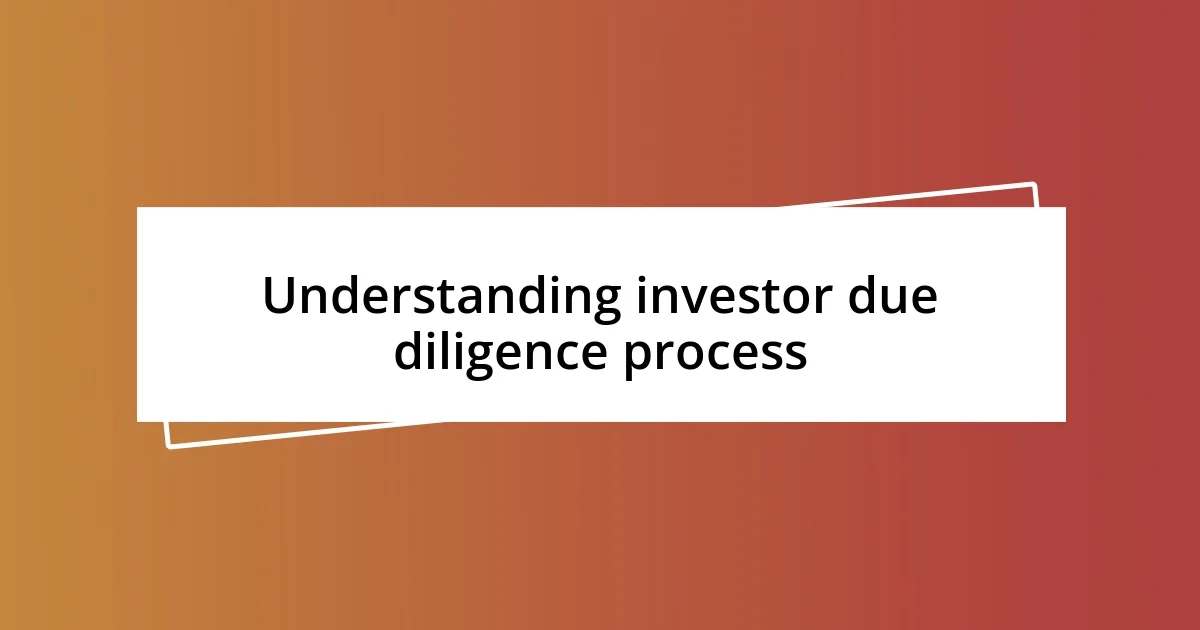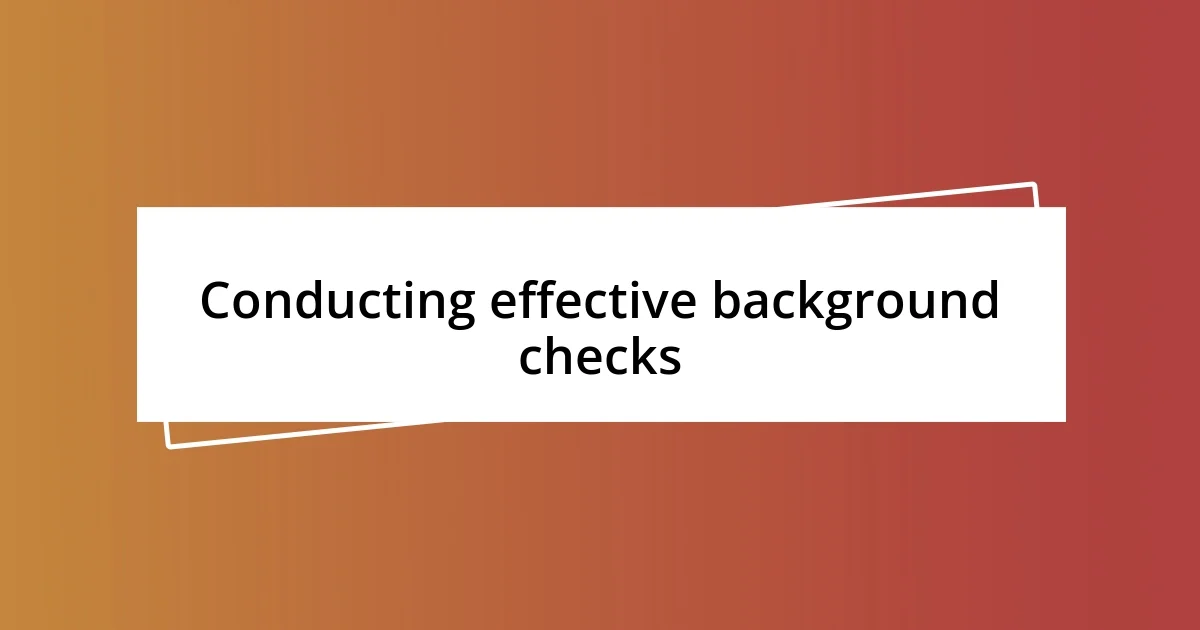Key takeaways:
- Effective due diligence requires a combination of thorough financial analysis and personal intuition, emphasizing the importance of understanding the story behind the numbers.
- Developing a comprehensive checklist tailored to specific investments helps ensure critical components—like financial health, market research, and management evaluation—are adequately assessed.
- Engaging legal and compliance experts early in the process can illuminate potential risks and complexities, ultimately leading to more informed investment decisions.

Understanding investor due diligence process
Understanding the investor due diligence process is crucial for making informed investment decisions. When I first delved into this process, I found myself overwhelmed by the sheer volume of information out there. It made me wonder: how do successful investors streamline their efforts while ensuring they don’t miss critical details?
As I navigated my way through financial statements and market analyses, I remembered the anxiety I felt during my first real investment opportunity. I had to recognize that due diligence isn’t just about numbers; it’s about uncovering the story behind those numbers. I started to ask myself questions like: What are the potential risks? Is this a sustainable business model? This introspection helped me approach the process more critically.
Throughout my journey, I learned that effective due diligence involves combining research with personal intuition. When I decided to invest in a startup, I not only analyzed their financials but also spent time with the founders. Their passion and vision were evident, and that emotional connection gave me the confidence to proceed. It showed me that due diligence isn’t just a checkbox—it’s an engaging exploration into the very essence of the investment.

Key components of due diligence
When I think about the key components of due diligence, a few critical areas stand out. I found that paying meticulous attention to financial health is essential. This includes scrutinizing profit margins, cash flow statements, and balance sheets. A particular instance comes to mind when I evaluated a tech start-up. I was initially captivated by their innovative solution, but once I dug into their financials, I discovered some alarming red flags in their cash flow. It was a sobering reminder that numbers often hold the real narrative.
Here are the core components I focus on for thorough due diligence:
- Financial Analysis: Examine income statements, cash flow statements, and balance sheets.
- Market Research: Assess industry trends, competition, and target audience.
- Management Evaluation: Research the backgrounds, capabilities, and track records of the leadership team.
- Legal Compliance: Verify regulatory adherence and scrutinize any ongoing litigation history.
- Operational Insights: Analyze business model efficiency and supply chain integrity.
These elements, when pieced together, create a comprehensive picture that helps mitigate risk and guide investment decisions. Each component has its own weight, and my experience shows that neglecting even one can lead to unexpected surprises down the line.

Developing a comprehensive checklist
When developing a comprehensive checklist for investor due diligence, I always start by identifying the fundamental components that required rigorous inspection. The first time I created such a checklist, I was surprised by how thorough I needed to be. Each item I included wasn’t just a box to check; it represented a layer of safety for my investment. By categorizing elements like financials, market insights, and management evaluation, I felt significantly more organized and confident in my approach.
Over the years, I’ve learned the value of personalization in crafting these checklists. For instance, during my due diligence on a promising company, I included a section solely dedicated to assessing the impact of management decisions. It brought back memories of a past, somewhat grim investment where I had neglected this aspect. Their leadership’s questionable integrity led to disastrous results. Making this a non-negotiable area of focus has since helped me avoid similar pitfalls.
I’ve found that continually updating your checklist based on evolving market trends is equally essential. In my experience, a checklist is not static—it needs to reflect what’s happening in the marketplace and the specific space of the investment. This adaptability has been pivotal for me. When I look back on my journey, I remember mistakenly relying on outdated practices; adapting to current times is now one of my top priorities in due diligence.
| Checklist Component | Importance |
|---|---|
| Financial Analysis | Critical for assessing financial health and sustainability. |
| Market Research | Helps understand competitive landscape and industry trends. |
| Management Evaluation | Reveals leadership capabilities and ethical standards. |
| Legal Compliance | Ensures adherence to regulations and minimizes legal risks. |
| Operational Insights | Evaluates efficiency of business operations and supply chain. |

Conducting effective background checks
When conducting background checks, I find it crucial to dig deeper than surface-level information. In one instance, while researching a potential partner, I stumbled upon an obscure article detailing previous legal issues that the company had faced. It wasn’t mentioned in their pitch deck or during meetings, and discovering it made a substantial difference in my decision-making process. It begs the question: how often do we overlook those hidden corners that could save us from a costly mistake?
The process of gathering information should be systematic yet flexible. I remember the time I was assessing a startup in the renewable energy space. While I had all the standard data, I decided to connect with a few former employees. Their insights about the company’s culture and management practices were enlightening and highlighted inconsistencies in the information provided by the founders. It’s moments like these that remind me: background checks aren’t just about gathering data; they’re about listening to stories and understanding the people behind them.
Finally, leveraging technology can elevate the thoroughness of your checks significantly. I often utilize platforms that provide in-depth reports and risk assessments, but what stands out to me the most is the power of networking. Reaching out to industry contacts often leads to invaluable, candid perspectives. This blend of technology and human insight creates a fuller picture of an organization’s integrity and potential. Have you ever thought of how intertwined human relationships and technology can be in due diligence? I’ve learned that both are essential for making informed investment choices.

Analyzing financial statements thoroughly
When I dive into financial statements, I look beyond the numbers; it’s about understanding the story they tell. For instance, while analyzing a company’s income statement, I once noticed a sudden spike in revenue that seemed too good to be true. On further investigation, it revealed a one-time sale rather than sustainable growth. This experience taught me that surface-level figures can mask underlying issues, urging me to always dig deeper.
I’ve found that examining trends across multiple periods provides invaluable insights. During one of my assessments, I compared the cash flow statements across several quarters and identified a consistent decline in operational cash flow, which was alarming. What stood out to me were the management’s explanations, which felt evasive and raised a red flag in my mind. Have you ever considered how a slight shift in cash flow can signify deeper struggles? It’s a critical aspect that should never be overlooked.
To truly grasp a company’s financial health, I also pay close attention to key ratios. Ratios like the debt-to-equity can reveal the level of risk associated with an investment. In one situation, while assessing a company, I discovered they had an unusually high debt-to-equity ratio. This prompted me to question their future growth prospects and whether they could weather economic downturns. My takeaway? Financial statements are not just documents; they are a treasure trove of insights waiting to be uncovered if you approach them with curiosity and a critical eye.

Engaging legal and compliance experts
Engaging legal and compliance experts is an essential step in my due diligence process. I recall an instance where I sought guidance from a compliance officer when evaluating a fintech company. They highlighted regulatory frameworks I hadn’t considered, which made me appreciate how nuanced compliance could be. It’s easy to underestimate the complexities in regulatory landscapes, but enlisting the right expertise can illuminate those blind spots.
Working closely with legal professionals can also help identify potential pitfalls buried in contracts or partnerships. I once dreaded going through a lengthy agreement, but a legal expert’s insights revealed clauses that could have led to significant liabilities down the road. Their knowledge transformed my understanding of the document from a tedious task to a vital mission of protecting my investment. How often do we skip the fine print? That experience reinforced my belief in the power of specialized knowledge.
Moreover, I find that including compliance experts in the early stages of the process can save time and resources in the long run. There was a project where I hadn’t initially integrated legal advice, thinking I could navigate the landscape myself. It turned into a detour fraught with complications. This taught me that having these experts on board can provide clarity and confidence, enabling me to focus on what truly matters—building a successful and sustainable partnership. How about you? Have you ever experienced the relief that comes from knowing you have an expert in your corner?

Presenting findings to stakeholders
Presenting findings to stakeholders is a critical moment in the due diligence journey. I remember one time, standing in front of a group of investors, feeling the pressure to clearly convey my findings. To ease that pressure, I focused on storytelling, framing the data in a way that connected the numbers to our overall mission. Have you ever noticed how a personal narrative can keep people engaged? It becomes less about the figures and more about the journey we can all embark on together.
Visual aids have been a key ally in my presentations. I once used infographics to break down complex compliance risks in a way that made them digestible. Watching stakeholders lean in as I unveiled each graphic was incredibly rewarding. Did you know that a simple chart can sometimes drive home a point more effectively than words? It’s true; visuals can simplify dense information, allowing everyone to grasp the essence quickly.
However, it’s not only about the data—it’s about addressing concerns proactively. In one instance, stakeholders were worried about potential market shifts. Anticipating their skepticism, I included various scenarios that illustrated how the company might adapt and thrive under different circumstances. By acknowledging their concerns upfront, I felt I built a sense of trust and engagement. How often do we provide space for questions and discussions in our presentations? Creating that dialogue can transform a simple report into a collaborative exploration of possibilities.














